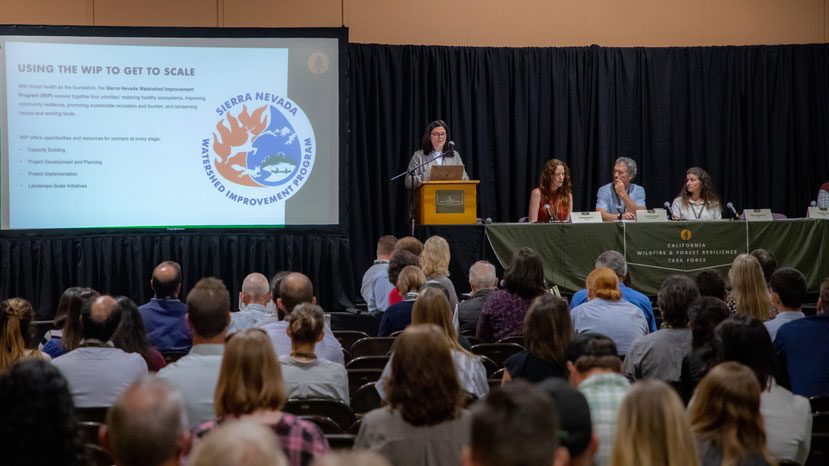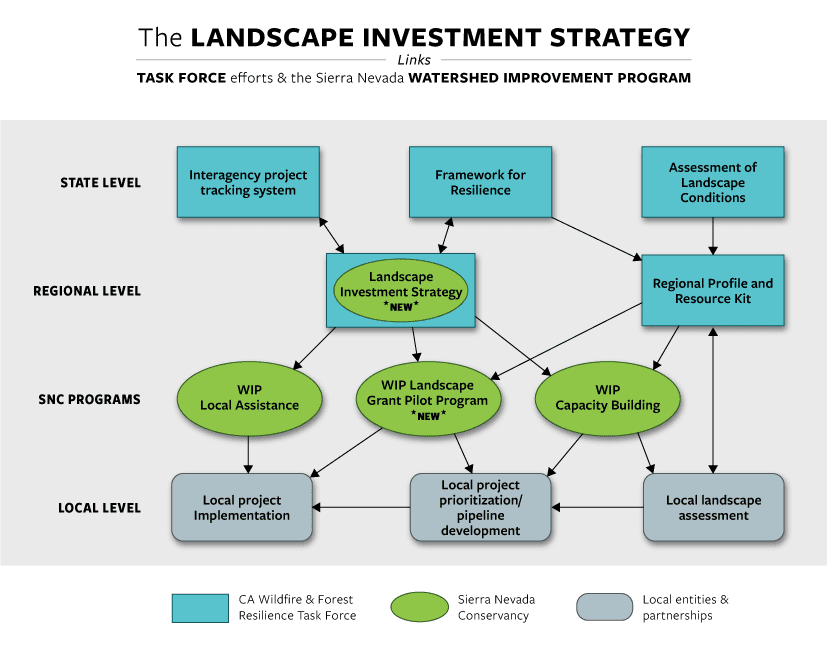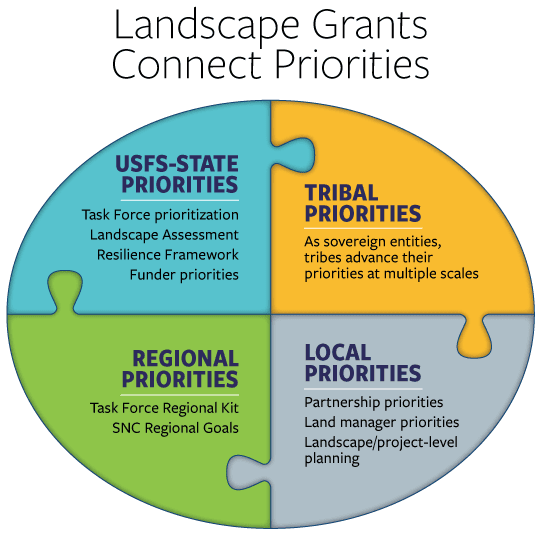
Getting to scale.
For more than a decade, the Sierra Nevada Conservancy (SNC) has been investing in projects and partners that support the environmental, economic, and social well-being of its service area. With forest health as the foundation, the Watershed Improvement Program (WIP) weaves together four priorities: restoring healthy ecosystems, improving community resilience, promoting sustainable recreation and tourism, and conserving natural and working lands.
As SNC Executive Officer Angela Avery explained at the Sierra Nevada meeting of the Governor’s Wildfire and Forest Resilience Task Force, “We started the WIP as a holistic approach to forest health and forest resilience. But what we started doing with this program is investing in individual projects across the landscape—really good projects, really important projects. But individual projects across the landscape.”
And yet, even as SNC has worked with state and federal partners to invest in science-based efforts to restore resilience, the pace and scale of Sierra Nevada and California Cascade forest health and wildfire crises have outpaced our collective efforts.
With historic amounts of state and federal funding flowing toward wildfire-resilience work in recent years, we’re hopeful that is about to change.
These investments are guided by the California Wildfire and Forest Resilience Action Plan and a Shared Stewardship Agreement between California and the U.S. Forest Service, each with a goal of treating 1 million acres per year in California by 2025. Containing 27 million acres, half of the state’s forests, and watersheds that provide water to more than 75% of Californians, the Sierra Nevada and California Cascade region is critical in achieving these goals and safeguarding the California way of life.
Sierra Nevada Landscape Investment Strategy
The Sierra Nevada Landscape Investment Strategy details the approach the SNC has developed to meet shared state and federal goals in our region. Much of this strategy involves doing more of what we know works—providing WIP implementation grants, capacity-building support, and technical assistance to our local partners.
But it also includes something new, a Landscape Grant Pilot Program.
Made possible by increased state and federal funding and cooperation, the Landscape Grants will give land managers a new tool that seeks to meet the wildfire crisis where it is occurring—at the landscape level.

Landscape Grant Pilot Program
The Landscape Grant Pilot Program will seek to align funding from multiple entities to provide one or two large landscape grants that support strategic portfolios of projects across large landscapes over a 5- to 10-year timeframe. In so doing, it seeks to test whether this approach can reduce administrative time and costs for funders and implementing partners alike and how brand-new datasets and decision-support tools developed by the Wildfire and Forest Resilience Task Force, can help land managers meet shared goals.
The program remains under development with $10 million dollars committed by CAL FIRE and active conversations ongoing with additional funders.
Natural Resources Secretary Wade Crowfoot responded favorably to the Landscape Grant Pilot Program at the Task Force Meeting, noting the potential for it to greatly simplify administrative burdens for local leaders.
“We have an exceedingly complex funding landscape and we can’t expect communities or local leaders to navigate those complexities to get things done on the scale we need to,” said Secretary Crowfoot. “So, I appreciate what Angie and the Sierra Nevada Conservancy are trying to do to take that up, to figure out how we can really bundle different pots of money in ways that can really be productive.”

Getting to scale
Landscape grants, unlike other components of SNC’s WIP, focus exclusively on working at scale. To be eligible for the Landscape Grant Pilot Program, a partnership must demonstrate that it, and the proposed portfolio of projects, create multiple benefits across a large landscape. These landscapes should be clearly defined based on ecological considerations, and the project portfolio designed to achieve real and meaningful change within 5 to 10 years. While there is no strict minimum size, landscapes are generally expected to be a least 40,000 acres (the size of the smallest Hydrologic Unit Code 10 watersheds).
Partnership organizations must also be ready to work at this scale, demonstrating clearly defined governance, prioritization, and decision-making processes. The partnership should also be able to show broad-based interest group and tribal involvement and contain multiple entities capable of leading complex environmental reviews.
Testing new tools & approaches
Working at scale will present an ideal opportunity to test new data and landscape prioritization products created by the Wildfire and Forest Resilience Task Force. Local partnerships will lead the identification, development, and implementation of landscape-level priorities and project portfolios, and Landscape Grants will be an opportunity for partnerships to test drive new analytical tools and ground-truth datasets.
Aligning funding into a large award like landscape grant will also allow both funders and restoration partnerships to test whether, where funding goals align, it’s possible to reduce administrative, grant-seeking, and grant-making costs. On the back end, this pilot program will test whether funders can standardize disparate reporting requirements and improve our ability to coordinate and track the effectiveness of collective investments.
The Sierra-Cascade can’t wait
The pace of change in the Sierra Nevada and California Cascade region over the past decade has been dramatic, and at times heartbreaking. Vast landscapes have been transformed by unprecedented tree mortality and wildfire events driven by unnaturally dense forest conditions, drought, and climate change. While the challenges are many, the rapid and widespread restoration of forestlands to more resilient conditions promises hope that generations to come may yet benefit from the riches, and experience the wonder, of the Sierra Nevada and California’s Cascades. Our Landscape Grant Pilot Program is intended to be a part of that solution.

